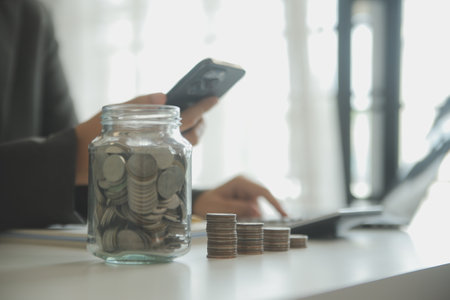Introduction to Emergency Fund Planning in the UK
Building a robust emergency fund is a cornerstone of financial security for households across the UK. In a landscape marked by unpredictable expenses, such as sudden job loss, urgent home repairs, or unexpected medical costs, having a dedicated reserve can make the difference between stress and stability. The importance of emergency funds has become even more pronounced in recent years, with rising living costs and economic uncertainty placing additional pressure on British families to plan ahead. Culturally, the UK has a tradition of prudent saving; however, many individuals still face challenges such as low savings rates and limited disposable income. According to recent surveys, a significant proportion of UK adults would struggle to cover an unplanned £500 expense without borrowing or resorting to credit. This reality highlights not only the necessity of proactive financial planning but also the need for practical tools that can help people save efficiently. As digital solutions become increasingly embedded in everyday life, money saving apps and financial management tools present new opportunities for UK households to build and maintain their emergency funds effectively.
2. Popular Money Saving Apps and Tools Used in the UK
When it comes to building an emergency fund in the UK, leveraging digital tools has become a popular and effective strategy. Several apps have gained widespread adoption due to their user-friendly interfaces, integration with UK banking systems, and features specifically designed to help individuals save effortlessly. Below is an examination of four leading money saving apps—Monzo, Plum, Chip, and Moneybox—detailing their unique characteristics and how they align with emergency fund planning.
Monzo
Monzo is one of the UKs most recognisable digital banks. Its key feature for emergency fund planning is the Pots function, which allows users to create separate savings pots within their account. This makes it easy to ring-fence funds specifically for emergencies. Monzo also offers round-up features, automated transfers, spending insights, and instant notifications—all useful for tracking progress towards your emergency savings goal.
Plum
Plum operates as an AI-powered app that analyses your spending patterns and automatically sets aside small amounts of money based on what you can afford. It offers rules-based saving options like Round Ups and Rainy Day Savings, making it particularly suitable for hands-off savers looking to gradually build an emergency buffer without manual intervention.
Chip
Chip uses artificial intelligence to calculate what you can safely afford to save each week and moves this amount into a dedicated savings account. The app supports automatic deposits, custom goals, and competitive interest rates on certain products. For those who want a frictionless way to grow their emergency fund without risking over-saving or dipping into essential cash flow, Chip provides robust automation.
Moneybox
Moneybox rounds up everyday purchases to the nearest pound and invests or saves the spare change. For emergency fund purposes, users can choose the cash savings option, which includes access to competitive interest accounts such as Cash ISAs. The app’s goal-setting features make it easy to track progress towards a target figure for your rainy day fund.
Comparison Table: Key Features for Emergency Fund Planning
| App/Platform | Savings Method | Automation Level | Interest Options | Best For |
|---|---|---|---|---|
| Monzo | Pots & Round-ups | High (scheduled & manual) | Savings pots with interest available | People seeking budget control & visibility |
| Plum | AI-driven auto-saving & rules-based triggers | Very High (fully automated) | Savings & investment options | Hands-off savers & automation enthusiasts |
| Chip | AI-calculated deposits & custom goals | Very High (fully automated) | Savings accounts with competitive rates | User wanting seamless auto-savings with flexibility |
| Moneybox | Purchase round-ups & direct deposits | Medium (user-initiated & automated) | Savings accounts including Cash ISAs | Savers interested in micro-saving & investments |
Selecting the Right Tool for Your Emergency Fund Strategy
The choice of app depends largely on your saving habits and preferences. If you value granular budgeting and transparency, Monzo’s Pots are ideal. Those preferring set-and-forget solutions will benefit from Plum or Chip’s advanced automation. Meanwhile, Moneybox is perfect for those who want to integrate micro-saving into daily life while having access to interest-bearing accounts suitable for short-term emergencies. Ultimately, combining these apps or selecting the one that aligns best with your lifestyle can significantly streamline the process of building a robust emergency fund in the UK context.
![]()
3. How to Integrate Saving Apps into Your Emergency Fund Strategy
Step 1: Choose a Reputable UK-Based Savings App
Begin by researching and selecting a savings app that is widely used and trusted within the UK, such as Monzo, Starling Bank, or Plum. These apps are regulated by the Financial Conduct Authority (FCA) and align with UK banking standards, ensuring your funds are protected up to £85,000 under the Financial Services Compensation Scheme (FSCS). When comparing options, consider features like automatic round-ups, interest rates, and user-friendly interfaces tailored to UK residents.
Step 2: Link Your Current Account
Once you have chosen an app, securely link it to your primary UK current account. This enables seamless transfers and allows the app to analyse your spending habits. Most apps employ Open Banking protocols for enhanced security and transparency. Ensure your bank is compatible with the app for uninterrupted service.
Step 3: Set a Clear Emergency Fund Target
Establish a realistic savings goal based on UK financial guidance—typically three to six months’ worth of essential expenses. Use in-app calculators or budgeting tools to determine this amount according to your rent/mortgage, utilities, groceries, and other non-negotiable bills. Setting a specific target helps maintain focus and motivation throughout your saving journey.
Step 4: Automate Your Savings Contributions
Take advantage of automation features offered by most UK savings apps. You can schedule regular transfers from your current account or enable ‘round-up’ options that save spare change from everyday purchases. Automation removes the temptation to skip contributions and ensures consistency even during busy periods.
Step 5: Monitor Progress and Adjust Regularly
Regularly track your progress using built-in analytics dashboards. Many apps provide monthly summaries, spending breakdowns, and alerts when you’re close to reaching your goal. Periodically review your emergency fund target—especially if your circumstances change—and adjust contribution amounts if necessary to stay aligned with your objectives.
UK-Specific Tips for Success
Consider setting up a dedicated ‘emergency pot’ within your app to separate these funds from general savings. Look out for seasonal offers or interest boosts provided by local fintech companies around payday or special events such as Black Friday. Lastly, remember that building an emergency fund is a long-term commitment; consistency and patience are key within the UK’s cost-of-living context.
4. Leveraging UK-Specific Features: Round-Ups, Savings Pots, and More
One of the standout advantages of using money saving apps in the UK is access to features specifically designed for local users. These functionalities—such as round-ups, savings pots, and cashback offers—are not only tailored to fit British banking systems but are also strategically effective for accelerating emergency fund growth.
Round-Up Transactions: Effortless Micro-Saving
Round-up features automatically round up each card transaction to the nearest pound, diverting the spare change into your savings pot. For example, if you buy a coffee for £2.70, an extra 30p is instantly transferred into your designated savings space. This incremental approach is highly effective for those who struggle to set aside lump sums, making it easier to build an emergency fund passively without feeling the pinch.
Savings Pots: Organised and Goal-Oriented Saving
Many UK-based apps such as Monzo and Starling Bank offer “savings pots” or “spaces”, enabling users to segment their finances according to specific goals—emergency funds included. By isolating your emergency savings from everyday spending money, you reduce the temptation to dip into these reserves. Additionally, these pots often allow for customisation, recurring transfers, and even interest accrual on balances.
Cashback Offers: Boosting Your Fund with Everyday Spending
Cashback schemes have become increasingly popular among UK digital banks and fintech apps. These programs reward users with a percentage of their purchase value when shopping at partner retailers. Redirecting these earnings straight into your emergency fund can accelerate its growth with minimal effort.
Comparison Table: Key App Features for UK Emergency Fund Building
| App Name | Round-Ups | Savings Pots/Spaces | Cashback Offers |
|---|---|---|---|
| Monzo | Yes | Yes (Customisable) | Limited Partners |
| Starling Bank | Yes | Yes (Interest Earning) | No Direct Cashback |
| Plum | Yes (AI-Driven) | Goal-Setting Envelopes | Partner Cashback |
| Lloyds Bank Save the Change® | Yes (Linked Accounts) | No Dedicated Pots | No Cashback |
| Curve | No | No | Bespoke Cashback Programmes |
Strategic Recommendation:
Selecting an app that combines round-ups, dedicated savings pots, and cashback options can substantially enhance your emergency fund strategy in the UK context. Users should assess which combination aligns best with their spending habits and savings discipline to maximise results while benefitting from familiar British financial infrastructure.
5. Best Practices and Security Considerations
When integrating money saving apps and tools into your emergency fund strategy in the UK, prioritising security and best practices is essential. With a wide array of digital financial services available, it’s crucial to ensure your personal and financial data remains protected while also maximising the benefits these platforms offer.
Data Protection and Privacy
The UK’s data protection regulations, such as the Data Protection Act 2018 and the UK GDPR, provide robust frameworks for safeguarding your information. Always review an app’s privacy policy to understand how your data will be used and stored. Opt for apps that use end-to-end encryption, do not share your details with third parties without consent, and are transparent about their data handling processes.
App Security Features
Security should be non-negotiable when selecting any financial app. Look for features such as biometric authentication (like fingerprint or facial recognition), two-factor authentication (2FA), and timely security updates. These measures add extra layers of protection, reducing the risk of unauthorised access to your emergency fund or sensitive information.
Choosing Regulated Providers
In the UK, always check if a savings app or tool is regulated by the Financial Conduct Authority (FCA). FCA regulation ensures that providers adhere to strict standards regarding customer protection and operational integrity. Many reputable apps will display their FCA registration number on their website or within the app itself—verify this directly via the FCA register for peace of mind.
Practical Tips for Safe App Usage
- Download apps only from official sources like the Apple App Store or Google Play Store to minimise malware risks.
- Regularly update both your device software and apps to benefit from the latest security patches.
- Avoid using public Wi-Fi networks when accessing your financial apps; instead, opt for secure home or mobile connections.
- Create strong, unique passwords for each app and consider using a reputable password manager to keep them safe.
By adopting these best practices and choosing regulated providers, UK residents can confidently leverage money saving apps and tools to build a resilient emergency fund—without compromising on security or compliance.
6. Conclusion: Building Financial Resilience with UK-Focused Tech
In summary, effective emergency fund planning is a cornerstone of financial wellbeing, particularly in the UK where economic uncertainty and living costs can present unique challenges. Throughout this article, we have explored how money saving apps and digital tools tailored for the British market can help individuals track spending, automate savings, and access localised guidance. Key features such as round-up savings, in-app budgeting, and integration with UK bank accounts make these solutions both accessible and practical for everyday use. By leveraging technology specifically designed for UK users, you can establish a more consistent savings habit and gain greater visibility over your financial health. We encourage you to explore the wide range of apps and platforms available, from well-known names like Monzo and Plum to newer fintech entrants that respond directly to British consumer needs. Adopting these tools is not just about convenience—it’s a proactive step towards building resilience against unexpected expenses and securing peace of mind for yourself and your loved ones. Start small if necessary, but take action today: harness the power of technology to create a robust emergency fund that will serve you well whatever life may bring.


